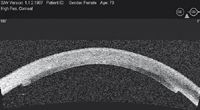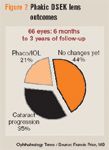Article
DSEK upsurge likely due to high satisfaction, good visual results
Descemet's stripping endothelial keratoplasty (DSEK) has changed the landscape in cornea surgery. Compared with those who have undergone penetrating keratoplasty, DSEK patients have an easier time postoperatively with rapid visual recovery. DSEK also affects decision-making about cataract extraction, and data appear to indicate that in most cases cataracts should be removed before DSEK or as a combined procedure.

Key Points
San Diego-Descemet's stripping endothelial keratoplasty (DSEK) has changed the landscape in cornea surgery. Compared with patients undergoing standard penetrating keratoplasty (PKP), DSEK patients have a much easier time postoperatively with rapid visual recovery, said Francis Price, MD, who spoke at the American Society of Cataract and Refractive Surgery. DSEK also affects decision-making about cataract extraction, and the data appear to indicate that in most cases cataracts should be removed before DSEK or as a combined procedure.

"There has been a big upsurge in DSEK as well as in the use of the femtosecond laser," said Dr. Price, in private practice at Price Vision Group, Indianapolis. "In the third quarter of 2006, 45% of the requests to the Vision Share Eye Banks in the United States were for tissue to perform endothelial keratoplasty. That is a dramatic change. We have only been performing DSEK for slightly more than 3 years."

In addition, even if patients have a loss of a line of visual acuity, they usually prefer the eye that underwent DSEK compared with the fellow eye with guttata or that underwent PKP.
"This is really a big change," he said.

"We found that, in our patients without pre-existing retinal problems or amblyopia, the visual recovery is rapid," Dr. Price said. "The vision did not recover to 20/20 in most eyes, and that is an area for improvement. However, by 6 months postoperatively, most patients have achieved 20/40 vision."
A consideration in those patients is that the postoperative visual acuity is correlated with the age of the patient.
"This is a reason for not putting off surgery in patients with Fuchs' dystrophy," Dr. Price said. "They have a chance of achieving a better level of vision if they are younger."
DSEK and cataracts
When planning cataract surgery, there could be new surgical considerations for the lens. As an example, Dr. Price presented the case of a patient with about 20/50 vision and guttata and some lens changes.




